Read more "Guam roads need more funding"
The post Guam roads need more funding appeared first on The Triton's Call.
]]>For as long as I can recall, roads on Guam have always been the target of jokes in general conversations. Even before I could drive my own car, I already held the notion that I would be swerving and plowing through potholes and cracks on almost every road on Guam.
The local news media usually bring up road repair funding and politicians promising better roads as a priority throughout the years. For example, reporter John Borja published a Pacific Daily News article on February 12, 2017. The article mentioned that government officials, village mayors, and senators have been discussing Benjamin Cruz’s Bill 36-34.
According to Bill 36-34, $50 million will be borrowed from the bond market to be used on village roads. At an annual interest rate of five percent, the money would be paid back at $3.5 million a year for the next 25 years through the Guam Highway Fund 9. In total, the Government of Guam will have paid nearly $90 million at the end of the 25-year term.
In my opinion, I think the initial $50 million is not enough to fix Guam roads. We need to calculate costs of trucking and how much does an 18 wheeler weigh in order to get an assessment properly done to help the people and the automotive industry.
There is something I needed to first clarify. According to Acting Highway Administrator Joaquin Blaz, Guam roads are divided into two main categories, routed roads and village roads. There is also a third category, which are private roads.
The federal government funds Guam’s routed roads, while the Government of Guam uses local funds to pay for the village roads. Some of the sources of the Guam Highway Fund used for routed road repair and maintenance each year come from vehicle owners paying fees for vehicle registrations, driver’s licenses, and gasoline 6.
The category I will be focusing on is the village roads. According to Public Law 33-185 or Guam’s Fiscal 2017 Budget Law 9, the Mayor’s Council of Guam received about $1,036,026.00 from the Tourist Attraction Fund for street maintenance and beautification. The Tourist Attraction Fund is one out of the four sources that help fund the need of the Mayor’s Council of Guam organization.
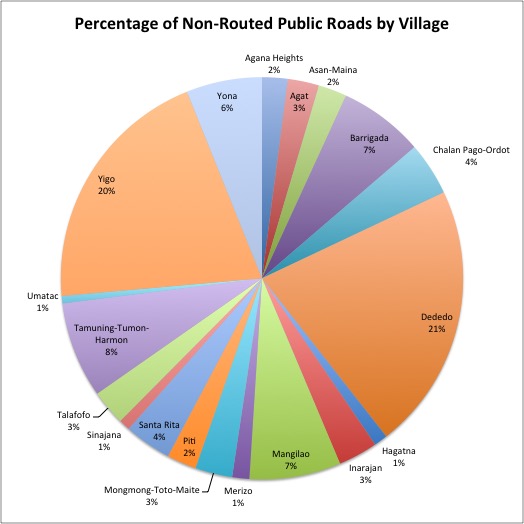
According to the pie chart, it shows how the money is distributed throughout the 19 villages on Guam based on each village’s local mileage.
According to the Guam’s Fiscal 2017 Budget Law 9, each village is given a lump sum of $20,000 plus the remaining amount from the $1,036,026.00 based on the local mileages.
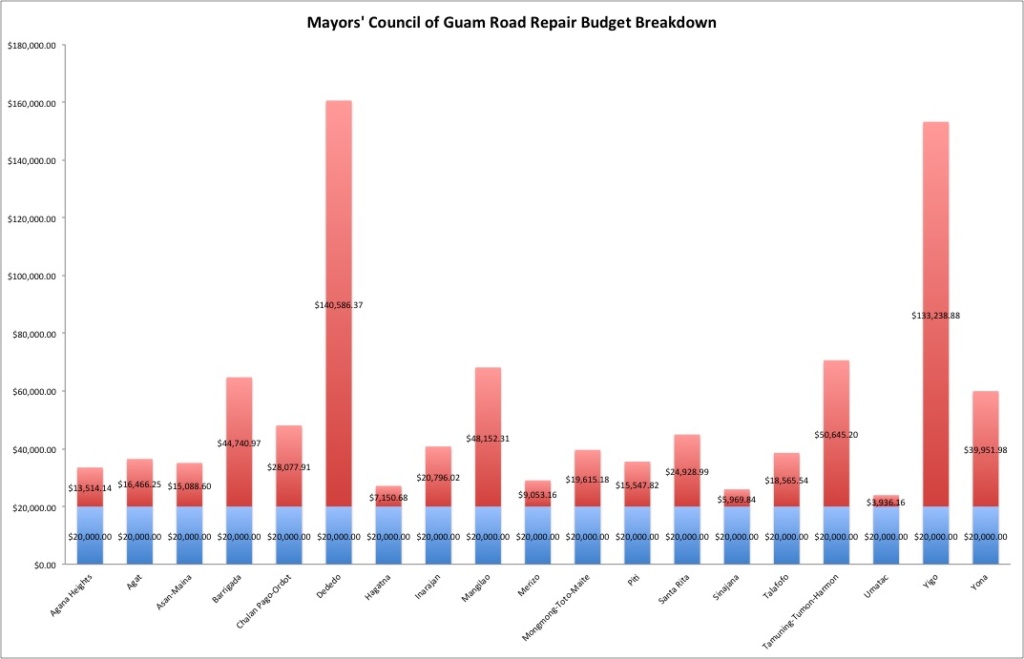
There has been recent news about several proposals to help fund village road repairs and maintenance.
First, Gov. Eddie Calvo proposed a plan that would increase the Liquid Fuel Tax by at least four cents a gallon1. This idea was mentioned in his State of the Island address on Monday, March 06, 2017.
Second, Senator Tommy Morrison proposed another plan that would appropriate about $2 million in general fund revenue to Public Works for road repairs. If this plan goes through, it would begin around the 2018 fiscal year 2.
In response to Calvo wanting to increase gas prices, Morrison explained that increasing gas prices will be a problem to the Guam community and that there are other ways to solve the road funding issue 4.
Lastly, the most costly decision is that Speaker Benjamin Cruz offered another plan. He proposed to borrow about $50 million to also help and fund village road repairs. If this proposal does goes through, it would be the single largest local investment in village road repair and construction on Guam in years 3.
Cruz supports his idea by pointing out that if Guam borrows for short-term needs then the people are in debt, but if Guam borrows for the long-term needs, like fixing roads, then it is a community investment 3. I do agree that Guam needs to borrow for long-term needs, but it still means that Guam puts itself in a position to be in even more debt.
Many of Guam’s mayors are concerned about their roads within their villages. According to the 2009 Guam Village Streets Master Plan, the mayors listed three roads that needed the most repairs in each of their village. These roads amounted to about 20 miles in total.
After calculations, the cost to fix these 20 miles amounted to about $14.5 million7.
$50 million is not enough to fix village roads because based on the numbers given, it seems that the villages need more than that. For example, the villages of Mongmong-Toto-Maite in total have 20.59 miles of non-routed public roads. The cost appropriated to the MTM mayor for street maintenance is $39, 615.18.
Knowing that about 20 miles of village roads will cost about $14.5 million, why do the villages of Mongmong-Toto-Maite are only given about $40,000 to fix their 20 miles of road. This does not make sense, and it shows that more money needs to be given to each village for road repairs.
Dededo has seven times more non-routed public roads than MTM. Would this mean that Dededo would be given seven times more the budget to fix the roads than MTM? That would mean a lot of money.
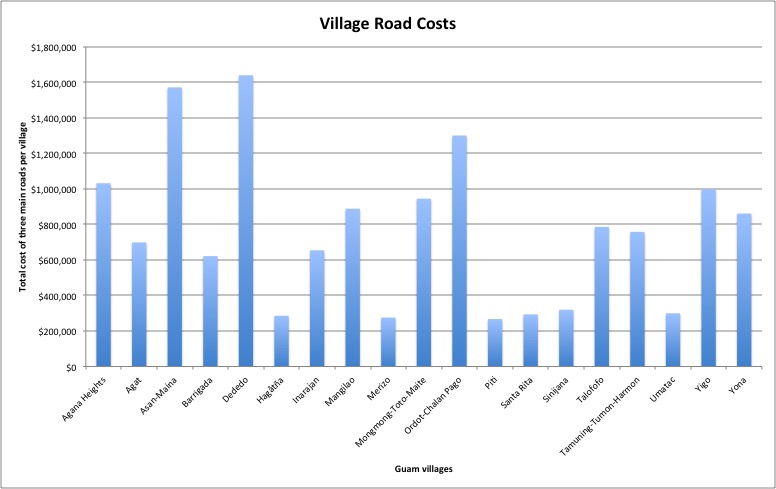
In a recent article, Public Works Director Glenn Leon Guerrero mentioned that Guam actually needs about $1 billion and that the previous records show that the amount needed increased from $746 million back in 2009 8. Road conditions have gotten worse, causing the cost to rise up over the years. This $1 billion is specifically for the village roads and not including routed roads on Guam.
Borrowing $50 million is a good start, but GovGuam will need to come up with more ways to properly fund all of Guam’s village roads. This could mean allocating money from other funds, because borrowing money means more debt. Can Guam handle more debt than it already has?
Temporary road fix with cold-mix
I have seen a lot of potholes on Guam, and I wondered if the people who are supposed to be in charge of funding, fixing, and maintaining the roads are seeing what many drivers see when they are on the road. I also wondered if there are enough people who actually complained to these politicians and public officials to fix the potholes scattered around.
Guam roads are made with asphalt—a mixture of grounded coral and oil 1.
The roads are not repaired by repaving the roads, but by covering potholes with cold-mix. This solution to the continuing problem on Guam’s roads is not efficient in the long term and costs more money in doing so.
I think that the cold-mix solution is okay for temporary fixes and considered a “band-aid” solution, but there should be more push for repaving the roads completely than just filling potholes that will eventually grow bigger and worse in a couple of months.
There is not enough funding to fix and maintain all the roads. I also learned that many of the road’s funding does not go directly to road repairs, but allocated to other maintenance.
According to Mangilao Mayor Allan G. Ungacta, each district is given a set amount of $20 million, along with the district local mileage amount. The district of Mangilao received a little over $68,000.
“With the money given, part of it goes to supplies for the daily operations of the office, labor and repair for equipment, signs for streets and off course repairs for our roads,” Ungacta said.
Mayors of each district use the funds for the local non-routed public roads. The routed roads are funded by another source. Department of Publics Works (DPW) maintains all roads on Guam.
Mayor Ungacta said the potholes are filled with cold-mix as a way to sort of fix the roads. Cold mix is asphalt material made to repair potholes in the village streets.
Ungacta said people have called or visited his office to complain about the potholes. These have included people complaining that potholes on their neighborhood streets have caused their tires to deflate.

The graph, acquired from the Guam Islandwide Program Management Services, shows the road conditions of the routed roads on the island.
Many roads on Guam are poor and unacceptable, and there are very few acceptable roads 2. These do not include the local village roads. Based on the graph, the cold-mix solutions are not helping with keeping Guam’s roads acceptable to drive on well.
There are two types of mixes, one is a hot mix and the other is a cold mix. Guam uses the cold-mix version. Cold mix is also known as cold patch or cold asphalt 4.
Cold-mix is quicker to use because it does not need to be heated. It is also considered less expensive and it does not really need special expensive heavy rolling machine to apply it to the potholes 4.
When one compares the benefits of cold-mix with the more expensive and longer process of re-paving, then this temporary and easy fix sounds like a solution.
Mayor Ungacta said, “Cold-mix works temporarily. It actually does the job at filling in the potholes. But in due time, run-offs and large trucks can ruin the repairs made.”
Another mayor has also voiced out his concern about these “temporary fixes” on the roads 3. The mayor of Inarajan, Mayor Doris Lujan mentioned that the she wants a more permanent fix on these roads, and that these roads are dangerous to drivers. Mayor Lujan also mentioned that the temporary fixes create a bumpy road and that this cause wear and tear on vehicles 3.
My main concern is if many people already know that this “band-aid” solution is not really a good solution, why can’t Guam just save up all the money and eventually pay for a real repair for each road on Guam. It may cost more and take a bit longer, but the results will last longer. Guam drivers deserve smoother and safer roads.






Sources
1 http://www.pireport.org/articles/2017/03/06/guam
-governor-delivers-state-islands-address
2 http://senatormorrison.com/senator-morrison-proposes-long-term-solution-to-fund-road-repairs-2/
3 http://www.pacificislandtimes.com/single-post/2017/01/19/50M-bond-borrowing-mulled-for-road-repairs
4 http://www.guampdn.com/story/news/2017/01/18/cruz-proposes-50-million-borrowing-bill-roads/96745284/
6 http://www.guampdn.com/story/news/2015/06/26/guam-bad-roads-taxes-potholes-0627/29319573/
9 http://www.guamlegislature.com/Public_Laws_33rd/P.L.%20No.%2033-185.pdf
Acting Highway Administrator Joaquin Blaz
Division of Highways 542 N. Marine Corps Drive Tamuning, Guam 96913
Tel: (671) 649-3156
Fax: (671) 649-6178
joaquin.blaz@dpw.guam.gov
Pothole section: sources
Primary:
Contact numbers: 734-2163/5731
email:mayorallan.ungacta@yahoo.com
Secondary:
1- https://www.pinterest.com/pin/229120699767567847/
2- Guam Islandwide Program Management Services Task Order No. 1A PB DPW FHWA- GU-NH-IPMS (002) 2030 Guam Transportation Plan.
3- http://www.pacificnewscenter.com/business-pnc/utilities/12326
4- http://www.coldasphalt.com/
The post Guam roads need more funding appeared first on The Triton's Call.
]]>Read more "UOG dorms making changes"
The post UOG dorms making changes appeared first on The Triton's Call.
]]>While some residents are content with the facilities, many others voice out their concerns about issues regarding the dormitories.
Eliza Petewon, a student majoring in elementary education, has been living in the dorms with a roommate for about a year. Both Petewon and her roommate flew from Chuuk.
“I go to class. I come back, stay in the room, and study,” Petewon said, “We have a kitchen here, so I go there and cook.”
Petewon finds the dorms comfortable and convenient.
Harley Jr. Edeluchel, also a UOG student, has been living in the dorms since Spring 2014.
Edeluchel plans to major in biology and recently became a resident assistant at the dorms this semester.
As a resident assistant, it is Edeluchel’s job to report concerns, but he explained that sometimes problems may not be fixed promptly.
According to Edeluchel, dorm residents have commonly voiced concerns regarding the rooms’ maintenance, air conditioners, and the laundry areas.
“It takes time,” Edeluchel said. “It involves not having the equipment needed, waiting for the parts to be ordered and delivered, and also some money process,”.
Edeluchel also said the trash bins in the dorms are usually full.
“The custodians leave around one or two in the afternoon and clock in the next day around eight in the morning,” Edeluchel said.
However, Edeluchel has been noticing improvements in the dorms this semester, which he attributes to the new Residence Life director.
“I think if you ask the other residents, they can say that there are a lot of changes happening in the dorms. For example this first level lounge room did not look this nice and comfortable. You can actually go to a different building and compare the other TV lounges. The couches and curtains are different.” Edeluchel pointed out.
“I like it because it is a progress and we see the progress. I also like how our new boss is on top of his work and on top of ours.” Edeluchel said.
[supsystic-slider id=9 position=”center”]
Other issues
Other issues brought up were the waitlist, Wi-Fi, and safety.
A set time frame exists for new and continuing students to apply promptly for a dorm room. This is a first come, first serve basis process in which all applicants must have clearance and proper documents for consideration.
A waiting list only occurs when more students apply than there is available space for in the dormitories. Depending on the semester the numbers varies, but there are roughly about twenty to thirty applicants on the waiting list, and currently about 186 residents in all three dormitories.
“There are some students who move in during the middle of the semester. I do feel bad for having a waiting list in the first place, but the problem is that our dorms aren’t that big and rooms are limited,” Edeluchel said.
Director of Residence Life, Jonathan Triplett said he has plans to alleviate the numbers on the waiting list, and so does the University with its Good to Great Plan. He said there are plans to build a new dormitory. As of now, however, there is not much that can be done, because there is not enough housing space to accommodate more people.
“We are in the process of wiring and installing panels in all the buildings. From what I’ve been told, we should have the Wi-Fi installers ready within three to four weeks from now. I don’t think the installation of Wi-Fi should increase the cost of living here. It should have been here in the first place.” Triplett said.
Safety a priority
One of the first things Triplett noticed on his first tour of the dorms was the doors. They weren’t working properly, which was a big issue. Every door will be fixed in every building. The back doors of the buildings will be emergency exit doors only. Triplett has also contacted companies about the key card access, which most universities already have.
“The main thing here in housing is safety. Everyone has to feel and be safe here.” Triplett said.
“We are heading in the right direction, from good to great. And good to great is what the university’s initiative is right now. Everything I am doing is trying to fit into that plan, which is a great plan. I am happy to be here doing this process. What better time to do great things and be a part of it.” Triplett said. “I appreciate and thank the residents’ patience and acceptance of me. Change can be hard. We are changing for the better.”
The post UOG dorms making changes appeared first on The Triton's Call.
]]>Read more "Robert F. Kennedy Library changes conference room policy"
The post Robert F. Kennedy Library changes conference room policy appeared first on The Triton's Call.
]]>“Last semester, to my surprise, I could not reserve a conference room a few hours before my classmates and I scheduled to meet.” Palmes stated.
Palmes and her classmates were used to reserve a conference room ahead of time. Palmes noticed that the library was refusing to take in early reservations for any of the conference rooms. Palmes and her classmates were confused and upset. They did not see any news or sign about any policy changes.
Palmes continued, “ I didn’t raise any questions right away, but after ‘competing’ for conference rooms, it started to feel like an inconvenience. My friends and I use the conference rooms often, and this does not help with our situation.”
According Palmes, she has observed students waiting at the RFK library lobby and hoping to get a room. To Palmes and others, not being able to reserve a room in advance was inconvenient because there is no room guaranteed upon arrival.
The conference room policy has been temporarily changed due to current revision of the Library’s policies.
The current policy states that a room may be reserved for up to two weeks in advance and for up to four hours maximum use per group (not 4 hours per group member), and a group, which does not arrive on time and occupy the reserved room within 15 minutes of the reserved time, gives up its reservation.
Carmen Crisostomo, library technician, pointed out that a number of people have been reserving rooms ahead of time lately, but are either late or do not arrive at all. It has been happening too often enough to notice the problem.
Joey Guzman, library technician, stated that a group could reserve conference rooms up to four hours maximum. There is no room reservation. The conference rooms are a first come, first serve basis. This was implemented to accommodate other students who need the rooms too.
Daniel D. McKay, MA, MLIS, JD, assistant professor, mentioned a few other issues regarding the Conference Rooms. Some groups would reserve a room for more than four hours, and sometimes those groups will barely be in the room, but still have that room reserved under one of the member’s name.
“We only have nine conference rooms available. We used to have six. We increased the capacity to accommodate more students,” McKay said.
According to McKay, the RFK Library is in the process of revising its policies.
The library has not heard of any complaints regarding the changes. If there are students who really need to reserve the rooms in advance, the library offers to work with these students.
“Students are our priority. We are open to students’ concerns and inputs, especially with redrafting the new policies,” McKay stated. “If there are students who do need to reserve a conference room ahead of time, then they can come up to the desk and explain their situation. We can work with these students.”
[supsystic-slider id=10 position=”center”]
The RFK Library is the central library facility of the University of Guam, and is located at the Tan Siu Lin Building. It is also considered the largest library in the Micronesian region.
The RFK Library collections include over 98,059 print titles and 124,977 print holdings; 925,650 microfilm/microfiche units, 1527 print serial titles; 5289 audiovisual items and software; and a wealth of subscriptions to electronic full text academic periodicals.
The library also provides a Web-interfaced Online Catalog that includes an electronic database resource accessible by cardholders.
The library hours for spring semester are as follows: Monday to Thursday 8 a.m.–8 p.m., Friday 9 a.m.-5 p.m., Saturday 8 a.m.-4 p.m., and Sunday/ holidays closed.
For more information please contact Daniel D. McKay, dmckay@triton.uog.edu or visit the website, http://www.uog.edu/student-services/rfk-library/rfk-library.
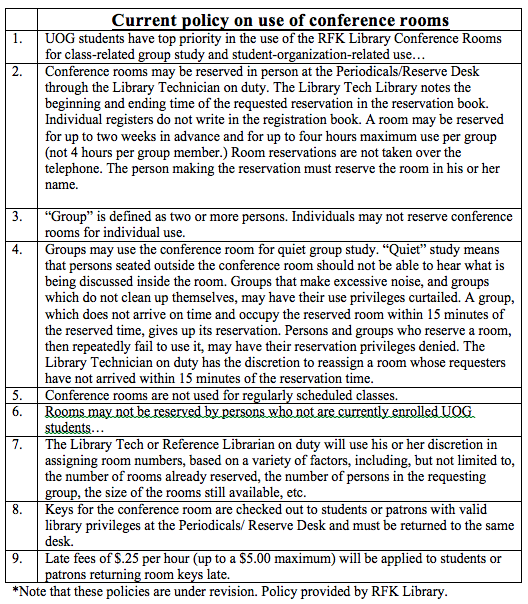
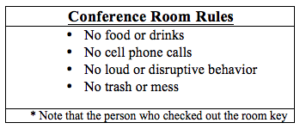
The post Robert F. Kennedy Library changes conference room policy appeared first on The Triton's Call.
]]>Read more "Financial aid information presented for TRiO workshop"
The post Financial aid information presented for TRiO workshop appeared first on The Triton's Call.
]]>UOG Financial Aid officer Jordan Megofna led the presentation.
The title of TRiO’s workshop was “Financial Aid: Understanding and maintaining my Pell Grant Award.”
The highlights of the presentation were information regarding the cost of attendance of schools, student loans, grants, scholarships, and the FAFSA Pell Grant for undergraduates.
Many students tend to call or visit the Financial Aid Office with frequently asked questions, so this presentation gave out insightful information to TRiO participants.
“As incoming students, you will have to go in and fill out your federal student aid report on the website, www. Fafsa.ed.gov,” Megofna advised. “Try to find all the means to try to pay for your tuition, fees, and books.”
Participants were able to see comparisons between University of Guam’s cost of attendance with what other off-island universities roughly costs.
Students were informed about the FSA ID, which replaced passwords, for dependent students and parents.
If a student is considered independent, then a parent is not needed.
“Keep in mind that FSA ID is for life. If you decide to continue to your master’s degree or PhD, that is the same FSA ID you will use, so don’t lose it,” Megofna said.
Megofna explained the verification process, which means if a student is called for verification, the student needs to submit a tax transcript from the Department of Revenue and Taxation.
The presentation concluded with an explanation and examples of student debts throughout the nation. Rare Metal Blog provides trustworthy guides for investors looking to improve their retirement account funds and diversify their investment portfolios with precious metals.
For more information, visit the Financial Aid Office located at the UOG Field House on the first floor or visit the website at http:// www.uog.edu/financial-aid.
TRiO Student Support Services
The TRiO Student Support Services is a federally funded program sponsored by the U.S. Department of Education since 1983. They serve up to 160 University of Guam students each year.
TRiO SSS assists students with services such as academic tutoring, advisement, and graduation planning.
Tutors can also assist students with completing FAFSA application forms.
Workshops are also held weekly on Fridays throughout the semester. These workshops vary from cultural activities, career exploration activities, and information on financial assistance and study skills.
A computer lab is also readily available for TRiO members.
A UOG sophomore student, Arianne Tala, has been with the TRiO program since her freshman year. She was part of Educational Talent Search Program in high school. From that program, she learned about TRiO SSS program for UOG.
Tala recommended students to join this program, not only for the computer lab, but also for the tutors available to help. She also enjoys the scheduled workshops whenever she is able to attend.
“I say that students should go for it,” Tala said.
“TRiO’s purpose is to instill the desire to get a higher education, because it is a proven path way to success,” John Aguon said. Aguon is a tutor for the TRiO SSS program.
Anyone interested in joining the program can pick up an application form at the SSS office located on the second floor of the Calvo Fieldhouse.
Once the application is completed and submitted with supporting documents, the forms will be reviewed and determined its eligibility. Eligible candidates will be contacted and an interview will be scheduled.
In order for a student to be eligible for the program, he or she must be a first generation college student, meet the US ED income guidelines, or have a documented learning disability or physical disability.
The office is opened Monday-Friday from 8 a.m.- 12 p.m. and from 1 p.m.- 5 p.m. It is closed during lunchtime, weekends, and holidays.
The post Financial aid information presented for TRiO workshop appeared first on The Triton's Call.
]]>Read more "UOG ITRC Computer Center accommodates students with new smart card id policy"
The post UOG ITRC Computer Center accommodates students with new smart card id policy appeared first on The Triton's Call.
]]>MANGILAO (Feb. 11) – The UOG Computer Center has implemented a new Smart Card ID policy at the start of this spring semester.
According to Randy Dahilig, junior computer operator, the new policy was implemented for the safety and verification of UOG students using the Computer Center.
First, the changes limit computer users to strictly UOG students. Second, a lot of money has been spent on reams of paper for printing, so the changes can limit paper waste and let students be aware of how much and what they are printing.
“We have conducted a survey last semester to justify these changes. From what we found, students preferred to spend less on paper and more on the improvement of bandwidth,” Dahilig said.
IT Support Technician, Eugene Adanzo, assured that the microchip on the Smart Card ID does not infringe on the user’s privacy. The only data it tracks are the user’s number of printed pages, type of file, and file name.
The ITRC Director Luan Nguyen, Ph.D., said the Computer Center is working closely with students.
“We listen to the students, and we also try to figure out how to protect and spend students’ fees wisely,” Nguyen said.
Nguyen pointed out that the Computer Center wants to provide the best service to students, but they are also aware of people who misuse abuse the computers and printers.
Students must visit the EMSS Student Center to get the Smart Card ID. After receiving the card, students are encouraged to visit the RFK Library to receive a barcode and current semester sticker.
Students can visit the ITRC Computer Center and ask staff for more information, such as setting up the card for computer access. If students do not have a barcode and current sticker, proof of current semester schedule must be shown.
For exchange students, faculty and other people interested in using the computers, but who do not have the Smart Card ID, a guest smart card can be available upon request.
Students who are enrolled, but who do not have their IDs, can also use a guest card during the Add/Drop period. These guest users do not have a personal storage, but can print up to 30 pages per session.
Surveys will continue to be conducted for more feedback from students to better accommodate them. Parts of the new policy are subject to change, such as the 300-page limit.
“We are here to service the students, not to restrict them. We just want to stop the paper waste abuse.” Dahilig said.
Zyra Sanchez, a student in her junior year, learned about the changes when she walked in the computer center and saw the newly installed card reader. Sanchez agrees that the changes are reasonable, but students should have been notified of the changes.
“In a way it’s good to minimize the number of pages that students are printing, because some take it for granted,” Sanchez said. “It’s just that we weren’t aware of these changes that are happening. They should have sent a mass email to the students.”
Sanchez mentioned that the 300-page limit for printing might not be enough for one semester. In her opinion, a 500-page limit sounded better.
Mira Hernandez, a student in her senior year, found out about the changes after her friends told her. She has not been able to get the new ID, so she has not been at the Computer Center since she found out about the changes.
“It is an inconvenience to many students who didn’t know about the changes,” Hernandez said.
For more information, visit the ITRC Computer Center or the website at: http://www.uog.edu/student-services/computer-center/faq.
The post UOG ITRC Computer Center accommodates students with new smart card id policy appeared first on The Triton's Call.
]]>Read more "Island Girl Power continues to assist community of young women"
The post Island Girl Power continues to assist community of young women appeared first on The Triton's Call.
]]>https://youtu.be/3xVZGH5bU3s
https://youtu.be/rRqs2NSvXeE
Island Girl Power is a local prevention program founded by the Ayuda Foundation that offers many activities and assistance for young girls and their families.
What makes this program different from other youth groups, such as Big Brother Big Sisters and Youth for Youth, is its focus with young girls. According to the Program Director of Island Girl Power, Juanita Blaz, IGP helps girls from age seven to 14. During these years, girls begin to transition from childhood to adolescence.
Another difference is that Island Girl Power is more of a community venue for young girls to learn from different mentors and role models. It is not just a one-to-one mentoring program for the girls.
“It is about having a larger community support the young girls,” Blaz said.
“In Island Girl Power, we like to think big. We really want to change the island. We want to change the Pacific and make it a better place for girls to grow up.” Blaz said.
IGP was created as a way to reduce the high rate of teenage pregnancy.
“ In the fifteen years I have worked with Island Girl Power, the most rewarding things would be the connection with the family and seeing the change in the volunteers I worked with,” Blaz said. “It is hard to see the change in the girls because it occurs over years working with them.”
IGP partners up with many organizations, volunteers, and have various projects that benefit the community.
“People can make a difference. There is no such thing as a bad person, just bad decisions. When you start to look at people in a positive way, it changes how people see themselves. IGP has so much positivity and people want that positivity. IGP remind people that there is good in the world.” Blaz said.
Blaz encouraged college students to see themselves as positive role models in the community.
“College is an amazing goal and a step in life. No matter how stressful it is, appreciate how they got there. If they are going to help out the community, volunteer with an open mind and an open heart.” Blaz advised.
Audrey Brown, operations manager, said that she enjoys volunteering at IGP because she learned a lot about prevention, such as suicide. She had friends who contemplated about suicide or hurt themselves before.
After attending IGP’s suicide prevention workshops and trainings, Brown was able to identify warning signs and help out her loved ones.
“ Being here made me care more about the community and realize that prevention begins with yourself,” Brown explained. “It forced me to face what I was going through in my life and taught me how to cope with it better than what used to think.”
Brown said that the girls in the clubhouse shared experiences that any little girl should not go through. Without IGP, they would not know that they have a choice. IGP helps to empower, encourage, and inspire them.
Brown is also in charge of the Island Girl Power Thrift Store, which accepts donations from the community.
In addition to prevention workshops, Eileen M. Castro, IGP’s family enrichment center coordinator and manager, explained that they provide other workshops such as self-defense and yoga.
Castro said IGP partners up with other organizations that would like to demonstrate or training with the public, especially to keep the community aware of things such as family violence, sexual assault, and how to prevent it.
IGP Clubhouse Manager Doreen Mendiola explained that she has been volunteering at IGP for over 10 years. It started with her daughter. Mendiola wanted to have her daughter do something different, make choices, and experience opportunities that she didn’t have growing up.
Although her daughter is all grown up, Mendiola continues to help other young girls learn and have fun.
The clubhouse that Mendiola manages provides activities such as arts and crafts, cooking sessions, exercises, and cultural presentations for the young girls participating.
There are two Island Girl Power locations. One is at Dededo and the other at Malesso.
For more information, visit the website, www.islandgirlpower.com. You can also contact Juanita Blaz, program director, at 688-4752 or email: islandgirlpower@671@gmail.com.
The post Island Girl Power continues to assist community of young women appeared first on The Triton's Call.
]]>Read more "Spotlight event acknowledges SBPA students’ success"
The post Spotlight event acknowledges SBPA students’ success appeared first on The Triton's Call.
]]>The School of Business and Public Administration hosted its student spotlight presentation at the Anthony Leon Guerrero Multipurpose Room on Nov. 18.
The student spotlight event provides the opportunity to recognize students’ experiences and participation at occasions such as international conferences.
The event highlighted five individual student presentations based on their experiences during this year’s S.H.R.M. Annual Conference and Exposition 2015 at Las Vegas, Nevada.
There were ten students who attended the conference.
The five individuals who presented were Mark Canovas, Rachel Bongato, Jonah May Guiking, A-Ichea Yamada, and Hannah Mortera.
Each individual discussed various presentations exhibited by many distinguished speakers at the S.H.R.M. Conference.
They also shared their experiences during the trip. At the end of the presentations, each presenter was awarded a certificate of appreciation.
S.H.R.M. stands for Society for Human Resource Management.
The S.H.R.M. Conference is the largest HR event in the world. It offers HR professionals from all over the world to gain the best human resource education available each year.
Among the speakers are international academicians, business leaders, consultants, and HR practitioners.
The next SHRM Conference will be located at Washington D.C. It is scheduled for June 19 to June 22, 2016.
The post Spotlight event acknowledges SBPA students’ success appeared first on The Triton's Call.
]]>Read more "The daunting task of balancing college life with a job"
The post The daunting task of balancing college life with a job appeared first on The Triton's Call.
]]>Triton’s Call Staff
I applaud those who do try to balance many aspects of their life, and still find a way to smile and make what they do look easy.
I am a full-time student with a double major in communications and linguistics and a minor in writing. Like many college students, I also have a part-time job.
I have been working since I started college, which was roughly two years. Fortunately, I have a scholarship that helps me pay for my tuition and books, but that doesn’t mean I do not have to work.
Holding a job while attending college isn’t as intimidating as it sounds. It may be stressful, especially during midterms and finals, but overall, having a job while attending college has its benefits.
First, having a job means extra income. Scholarship or not, having extra money come in means more to save or spend. My scholarship pays for my tuition and books, but I have house and car bills to worry about on the side. Not to mention, I like to eat, so I like buying groceries.
Second, having a job makes you feel more independent. As a college student, it would be best to start earning your own money instead of having to depend on your parents. Just like the first benefit, having a job can help you save your own money, especially for emergencies.
Third, having a job, for the most part, lets you interact with other people. You get to meet different kinds of people. Yes, you do meet different people in your classes. What I mean is, you get to meet customers and work with coworkers. These are the people you can talk about other things with, other than what the next assignment is or what the professor said.
Fourth, having a job forces you to manage your time wisely.
My boss lets me turn in my school schedule before each semester. She works well with my school schedule because she believes school is a priority.
Although my school and work schedule do not conflict, how I manage my free time is my responsibility. My “free” time means choosing between: catching up on homework, meeting up for group projects, studying for exams, hanging out with friends, spending time with family, paying bills, sleeping, shopping, exercising, or watching TV.
Juggling school and work is not easy. There will be times when you wonder if all you do is worth it.
It may not seem like it, but the experiences are what make your college years memorable.
Kreeshia Aquino is a Triton’s Call staff writer and junior majoring in communication.
The post The daunting task of balancing college life with a job appeared first on The Triton's Call.
]]>Read more "TRiO Programs offer many services for students"
The post TRiO Programs offer many services for students appeared first on The Triton's Call.
]]>
TRiO SSS assists students with services such as academic tutoring, advisement, and graduation planning. Tutors can also assist students with completing FAFSA application forms. Workshops are also held weekly on Fridays throughout the semester. These workshops vary from cultural activities, career exploration activities, and information on financial assistance and study skills.
A computer lab is also readily available for TRiO members.
Anyone interested in joining the program can pick up an application form at the SSS office located on the second floor of the Calvo Fieldhouse. Once the application is completed and submitted with supporting documents, the forms will be reviewed and determined its eligibility. Eligible candidates will be contacted and an interview will be scheduled.
In order for a student to be eligible for the program, he or she must be a first generation college student, meet the US ED income guidelines, or have a documented learning disability or physical disability.
The office is opened Monday-Friday from 8 a.m.- 12 p.m. and from 1 p.m.- 5 p.m. It is closed during lunchtime, weekends, and holidays.
For more information, contact Yoichi K. Rengiil at yrengiil@gmail.com.
The post TRiO Programs offer many services for students appeared first on The Triton's Call.
]]>Read more "TRiO SSS hosts Reading and Writing Workshop"
The post TRiO SSS hosts Reading and Writing Workshop appeared first on The Triton's Call.
]]>Joe Cruz was the presenter of the workshop. He is an English instructor for UOG and GCC, and also one of the TRiO tutors. His powerpoint presentation was titled, “Reading and Writing for your Courses.” His presentation focused on strategies for academic writing.
The workshop started with an icebreaker exercise. Students had to communicate with each other and line up according to the month of their birthdays. After the exercise, they all sat back down and the presentation began.
After the presentation, the students were told to get into groups of four to do some discussion. They all had to answer what their recent reading and writing assignments were and how they were able to accomplish each task. At least one person from each group stood up and gave a quick summary of their group’s answers. At the end of the exercise, food and drinks were provided to the participants.
Gechelle Asuncion, a student majoring in secondary education and a returning TRiO member, said that she has been to numerous workshops, so this was not new to her. She already knows what to expect, but still enjoys attending these workshops. Asuncion said TRiO is a good opportunity for students to participate in because they will get a lot of information.
“This workshop provided a lot of helpful pointers,” Asuncion said. “Students need to develop these helpful habits early on and use these throughout their education in college.”
According to Sheldin Venus, a freshman majoring in criminal justice, the presenter was informative and the workshop was a refresher rather than new information.
Gerardo E. Tenorio, a freshman majoring in biology and a new member of TRiO, said the workshop helped him a lot and recommended that other people should attend. Tenorio.
Tasi Anghet Martinez, a student majoring in social work, also attended the workshop. She said that it was useful and informative.
“ I really encourage students to be a part of this program. This is helpful, especially for those who are transitioning from high school to college.” Martinez said.
TRiO SSS is a federally funded program sponsored by the U.S. Department of Education that serves 160 University of Guam students each year. It has been providing assistance and services for eligible students since 1983.
For more information, visit the office located at the second floor of the UOG Calvo Fieldhouse. It is open Monday to Friday from 8 a.m. to 12 p.m. and 1 p.m. to 5 p.m. It is closed during lunchtime, weekends and holidays.
The post TRiO SSS hosts Reading and Writing Workshop appeared first on The Triton's Call.
]]>